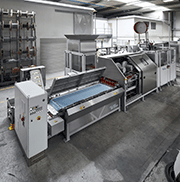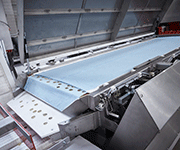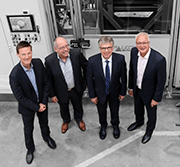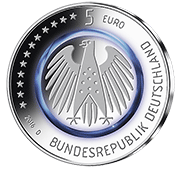E-Archive
Good Vibrations
in Vol. 17 - March Issue - Year 2016
Textiles For Better Finishing Results

Complete coin blank finishing line Z44BFC with dryer SFT 200, manufactured at Spaleck Oberfl

Textile Dryer SFT 200 with microfiber textiles with pocket format structure

Mint directors visiting Spaleck Oberfl

New 5 Euro coin coming in the first half of 2016
Since the beginning of mankind, textiles have played an important role for human beings. Thousands of years ago in the Stone Age, an untreated bearskin secured survival of homo sapiens in the northern European territories. The oldest cape ever found is approximately 23.000 years old and was located in the Italian cave of Arene Candide. It consisted of 400 strips of squirrel skins. Scientists think of a much older starting of textile wearing. There have not been any finds of prehistoric clothing, but they gain estimates out of the first occurrence of the body louse. So, there are genetic analyses, which are giving hints that the usage of textiles started in a period 75.000 years ago.
Only in the Neolithic age before about 12.000 years with the domestication of sheep and the invention of weaving technology did humans begin to use wool to produce textiles. Much later, vegetable raw materials were also used for textiles, starting with linen and hemp.
Quality of textiles became important in the middle ages, where the very different clothing reflected the social standing of people. Textiles have developed into one of the most important trading goods between people and territories. Cloth finishing started, and has been paid very well.
Hundreds of years later, textiles became the most important driver for the first Industrial Revolution. Cotton and new equipment for its preparation and processing like spinning and weaving were the main impetus for the start of the Industrial Revolution. In 1830, for example, the cotton processing made up approximately 8 per cent of the gross domestic product in Great Britain and led to an explosive growth of cotton cities (e.g. Manchester).
Originally, textiles should protect humans from hypothermia and frostbite by cold, wet and wind. Protection against heat damage and sunburn was also relevant and it should at least not hinder the evaporation of sweat. Today there are many forms of special textiles in the form of usually normalized protective clothing such as bulletproof vests or chemical protective suits.
These uses of textiles have required a huge amount of research and testing in the textile industry, so that we have today a vast amount of knowledge about textile properties like fibers and woven structures. One of the results is the invention of microfiber.
Microfiber is a common term for fibers, of which the fineness is extreme high (less than 1 dtex, cotton has between 1,5 and 2,5 dtex). The fiber diameters are then dependent on the density of 3-10 microns. Human hair has a diameter of 50 - 70 microns. Microfiber fabrics are extraordinarily soft and dimensionally stable, and 10,000 m of such a microfibre weigh no more than 1 gram. Microfiber fabrics are very resistant to lint and have many interesting applications. Apart from clothing textiles, they are used as high performance wipes to clean very sensitive surfaces.
A couple of years ago a senior staff member of a surface finishing company noticed that special microfiber textiles have properties, which could not only be interesting for surface finishing, but which have the potential to change an entire industrial process: the drying of blanks.
Initial tests to use textiles to clean and dry parts started with simple towels. Month of developmental evolution ended at much more successful trials with microfiber textiles. After that, these textiles were specially modified and adapted by a textile partner company to be ready for machine integration.
The first concept of textile-supported drying of coin blanks was born. Before coin blanks are coined, they get a mass polishing treatment. It is important that the surface of the blank is prepared for the striking process. The right preparation during the surface finishing process will increase the die lifetime and will protect the blank against tarnishing, and it affects dramatically the quality of the final product - the coin.
The original textile drying method has changed its technical design over and over again, culminating in the actual SFT 200 version, which has been constructed and built to be integrated into larger and more complex surface finishing lines. These installations dispose of a huge amount of control and safety technology. They are combined with databases and reporting technology.
According to these immense technological changes in recent years, the job profile of an employee who is in charge to operate such a finishing machine has also changed widely. The qualification needed has risen enormously in order to be able to operate such complex technology. From the perspective of the entrepreneur, an investment with so far-reaching competitive potential is just such a sharp sword, if it is guided by a steady hand. The whole process image in the mint industry has been totally revalued, from a simple "washing" process carried out in barrels into a fully automated "surface finishing process including fully data capturing".
This fact is also reflected by the chemical and environmental side of the process. Special compounds with higher quality are used to keep the environmental burden at a minimum while they simultaneously shrink the long-term production costs. The current technological standard is able to recycle 100% of the used process water.
The manufacturing of the new 5 Euro coin will partly benefit from the new microfiber finishing process. During the stage of designing the new 5 Euro many samples needed to be finished - all via the new textile drying method. The two main developing mints from Germany (the Bavarian State Mint & the State Mints of Baden-Württemberg) have taken a closer look at the new technology!
Two of these most modern finishing lines from Spaleck Oberflächentechnik (Z44 BFC) were installed and commissioned in December 2015 in the UK and are now in full operation!
Good Vibrations
by Mathieu Geuting
Spaleck Oberflächentechnik GmbH & Co. KG, Germany
Tel. +49.2871.9500 14
Fax +49.2871.9500 95
E-mail: m.geuting@spaleck.biz




























